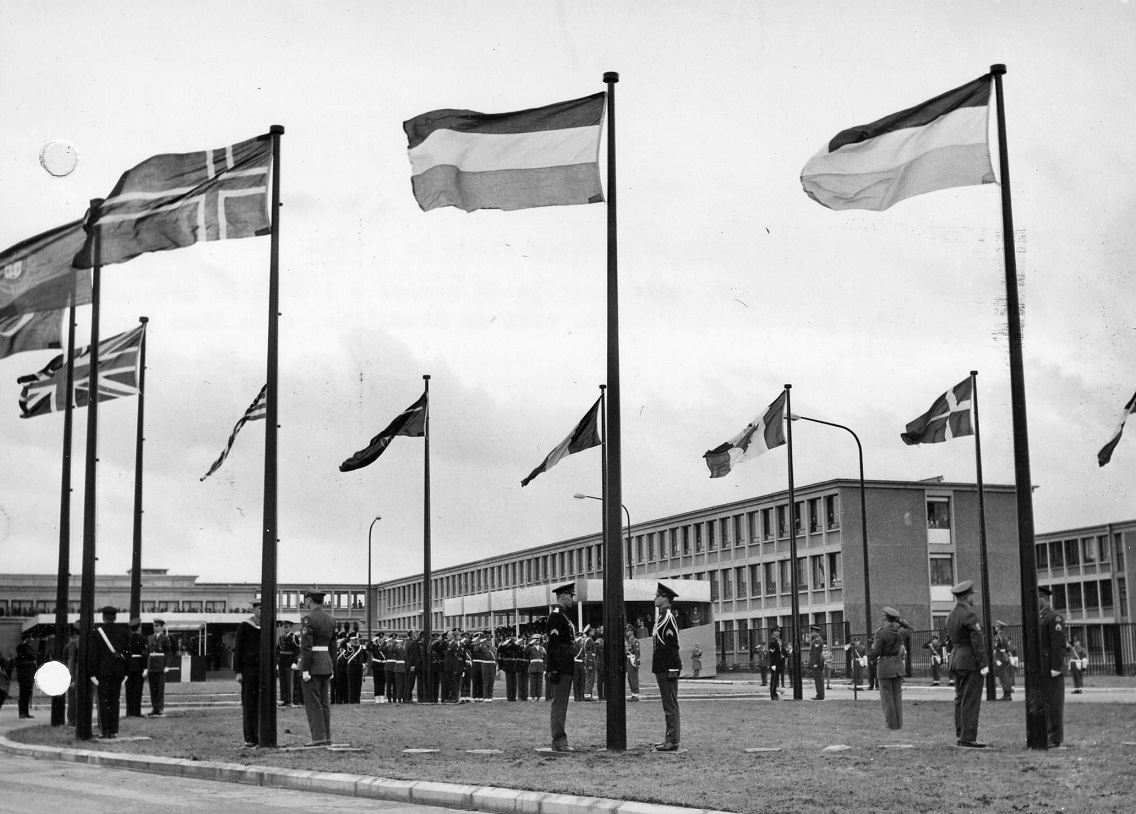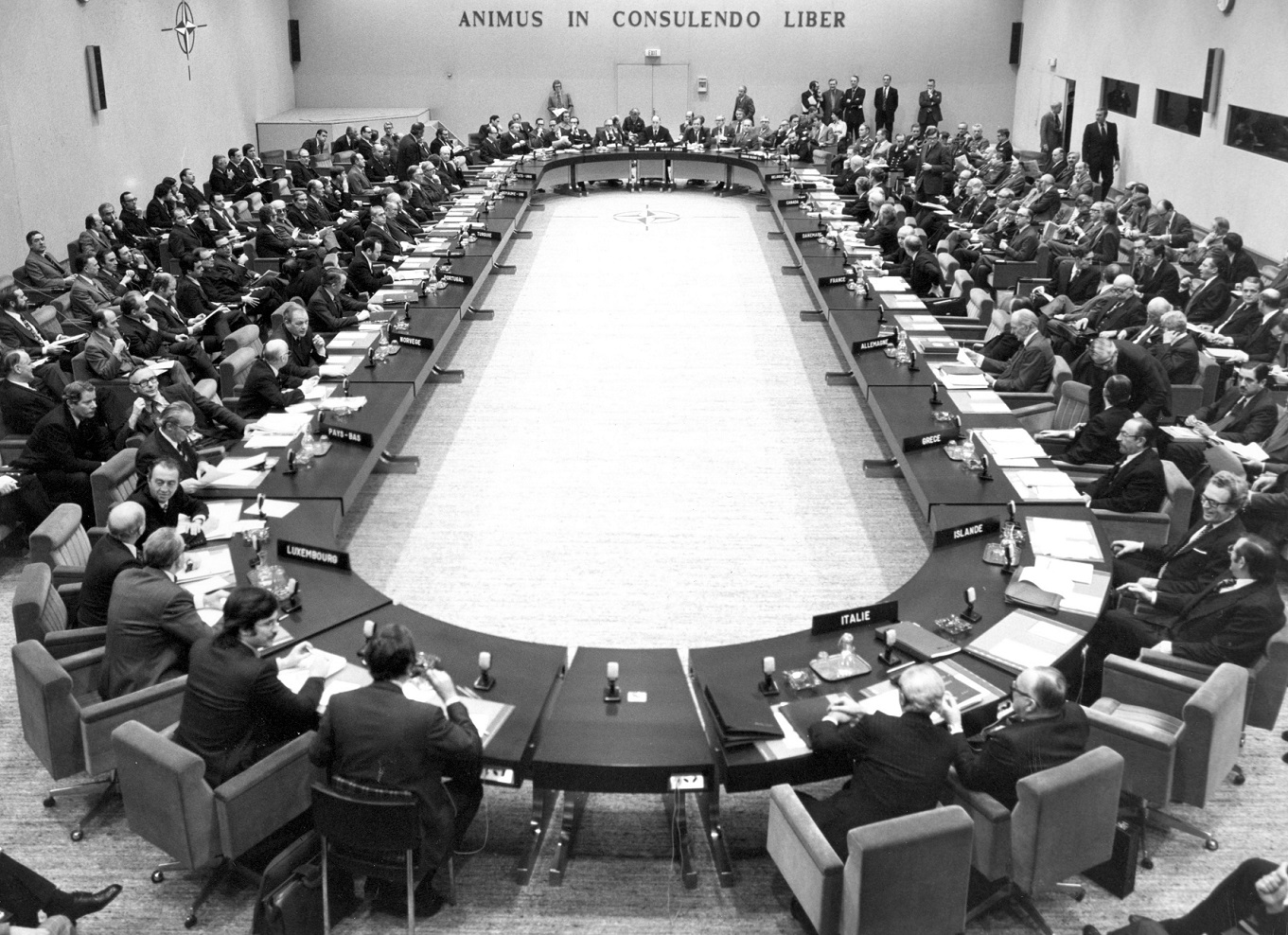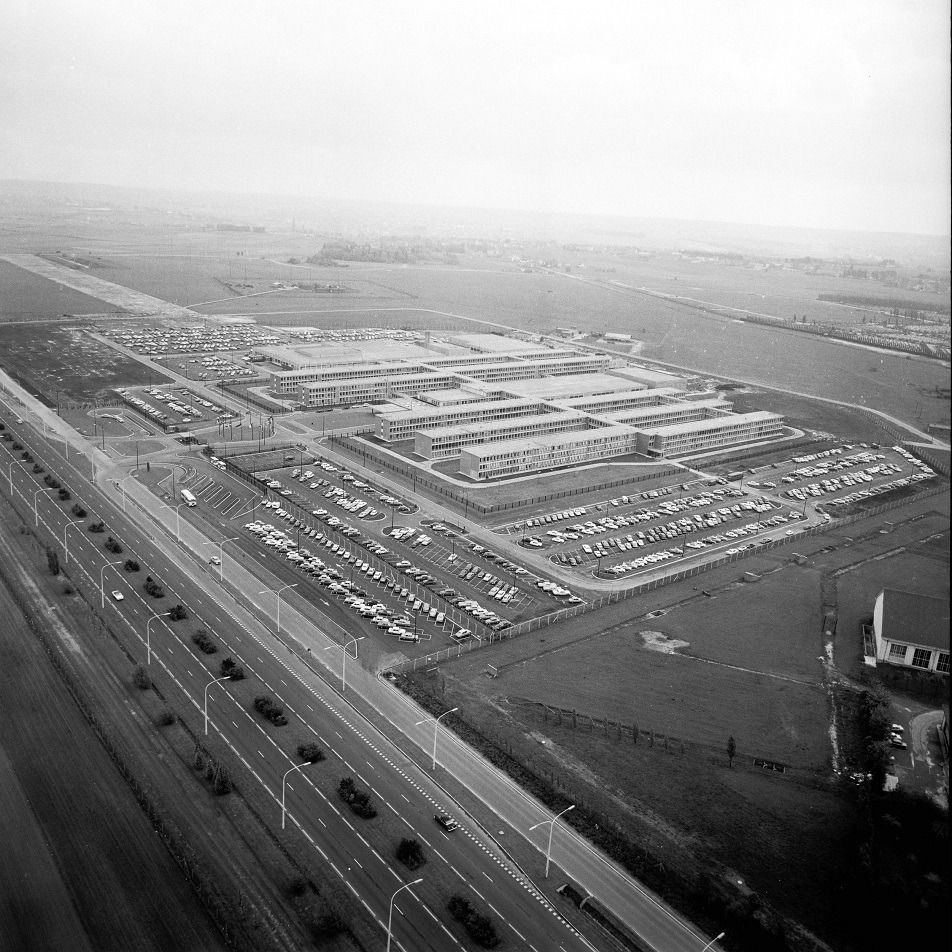I first arrived at NATO in October 1980. Flying into Zaventem from London was an easy way to reach the old NATO headquarters in Evere as it was only a five-minute taxi ride along the dual carriageway from the airport. Yet I soon discovered that this guaranteed you a frosty welcome from the local Brussels taxi drivers.
After queuing at the airport for a couple of hours and hoping for a juicy fare to Waterloo or Uccle, their faces turned to despair when you jumped in and said, “C’est pour l’OTAN, s’il vous plait.” The short journey would usually be taken up with a diatribe from the driver about how tough the métier of taxi driver was becoming (even in this pre-Uber age), a way of extracting a handsome tip from you upon arrival outside the HQ to make up for the paltry fare.
The old NATO HQ was a labyrinth of pre-fabs that extended across the parking lots as the years went by. As the alliance added more members and partners, they all needed accommodation for their ambassadors, military representatives and delegations.
The building was originally intended to be a military hospital for the Belgian army. However, in 1967, General de Gaulle withdrew France from the alliance’s integrated command structure and ordered NATO to leave French territory. A temporary abode was urgently needed for NATO’s then-15 member state delegations, the Italian Secretary General, Manlio Brosio, and the international staff. With Brussels already hosting the EU institutions and other international bodies such as the Western European Union and Eurocontrol, the Belgians stepped up and invited NATO to come north.
Belgium obviously saw its chance to put Brussels on the diplomatic map even more firmly as the capital of Europe and the transatlantic community. There was money to be made too from the billions of Belgian francs that NATO personnel, their families and all the national officials travelling to NATO HQ for meetings every week from capitals would pump into the local hotels, restaurants, shops, car dealerships and property market.
Yet the prefab military hospital wasn’t quite ready. One of my favourite photos from the NATO history book shows, in suitably grim black and white, the flag-raising ceremony in the Cour d’Honneur outside the entrance to the new HQ in the winter of 1967. The ambassadors stand shivering in their overcoats and surrounded by a sea of mud as the NATO pole star emblem is raised slowly up the central pole.
Half-century in temporary digs
The military hospital was not intended to be a permanent affair. Yet at least the NATO civilians were more or less in Brussels, a big city and the capital of Belgium, close to an airport, next door to the major international motorways and not so far from the Midi station with its multiple escape routes to the rest of Europe.
They avoided the fate of their military colleagues from SHAPE, NATO’s military supreme command, who had to relocate from Rocquencourt near Fontainebleu to Casteau, in the heart of Belgium’s black country around Mons. This was a deliberate decision by the Belgian government to stimulate employment in a poor, rustbelt part of the country.

The inauguration of the NATO headquarters in Evere. Credit: Belga
But making NATO’s civilian and military officials take a one-hour drive to visit each other was probably not the most efficient way to defend the West against the Soviet Union, especially when you considered that their EU counterparts at the time had only to walk 30 metres from the Commission in the Berlaymont building to the Council in the Charlemagne building next door.
Fortunately, the head of SHAPE, the alliance’s Supreme Allied Commander Europe (SACEUR), always an American four-star general or admiral, was able to fly over the traffic jams between Casteau and Evere in his own US army helicopter. The landing pad at NATO HQ was close to my office and I well remember the loud racket made by the rotors as the big bird touched down. It was a good excuse to down tools and slope off to the coffee bar for a 15-minute break.
Those were the days. The Cold War stalemate, at least as far as Europe was concerned, meant that little went on at NATO HQ. The alliance’s raison d’être seemed principally to exist, to be there as a counterweight to the Soviet Union. Nothing happening from one day to the next meant that deterrence was working. Activity would have meant war, and a potentially catastrophic nuclear exchange. Nobody wanted that, including the Communist leaders in Moscow, thank God.

NATO foreign ministers meeting 1975. Credit: Belga
This gave daily working life inside NATO a well-paced and slightly boring feel. There was one meeting of NATO ambassadors in the North Atlantic Council every week and just a few meetings of NATO foreign or defence ministers a year. The ministerial communiqués from one year bore an uncanny resemblance to those of the year before. Certainly, made them easier to write. When asked how many people worked at NATO HQ, my first boss as Secretary General, Jozef Luns of the Netherlands, replied, “About half”.
All of this seems a far cry from the NATO of today, which is in perpetual crisis management mode. It is the news headlines several times a month and is set to welcome Finland and Sweden as its 31st and 32nd members. Now NATO ambassadors frequently meet eight times a week, NATO has held three summits in little over a year, ministers meet in person or virtually round the clock, and people actually know the name of NATO’s current Secretary General, Jens Stoltenberg.
Back in the good old days, by contrast, people tended to disappear after Friday lunch. Many of my NATO colleagues were old-timers from the Paris days who clung to the dream of returning one day. The fact that NATO was housed in a temporary and seemingly unsuitable location on the outskirts of Brussels gave credence to the comforting illusion that the HQ was not meant to be in Brussels and would return to its natural French home before too long.
Yet the move back to Paris never happened. Even when President Nicolas Sarkozy brought France back into the alliance’s integrated military command structure in 2009, there was still no talk of reopening the doors of the Trocadero. Of course, by this time NATO had been in Brussels for 40 years and Belgium had become its truly natural and permanent home. In 1999, NATO leaders agreed to finally build for the alliance a proper, more functional and becoming HQ in Brussels, sealing its association with Belgium no doubt for as long as the alliance continues to exist.
Glass, steel and lots of space
NATO’s new HQ, which finally opened its doors in the spring of 2018, cost over €1 billion and represented one of the most innovative designs in recent European architecture. As if anticipating future rounds of enlargement, the building was double the size of the old, sprawling HQ on the other side of Boulevard Leopold III. It offered a lot more glass and technology and an in-house Costa Coffee shop and a supermarket.
One instant benefit was that NATO officials no longer needed to be jealous of their EU counterparts, occupying more modern and prestigious buildings around the Rond-Point Schuman. Nor would they feel embarrassed about their dilapidated accommodation, which was increasingly classified as a fire risk by the Belgian authorities.
Yet there were nostalgics for the now deserted prefabs across the road. This writer is one of them, unsurprisingly as he spent 38 years working in those prefabs. Yet, more objectively, the prefabs contained a massive chunk of modern European history.
Within their walls, Vaclav Havel and Lech Walesa expressed the desire of their newly free counties to join the alliance and return to the European family; NATO directed its operations in Bosnia and Kosovo; and after the September 11, 2001 terrorist attacks against New York and Washington, the alliance invoked its Article 5 mutual defence clause for the first (and so far only time) in its 73-year history.
The old HQ had other endearing features too. As it was small, it was also intimate. Working in close proximity facilitated human contact and made it easy for everyone to know each other. It made creative thinking and collaboration across the various policy areas relatively smooth. By contrast, the new HQ with its enormous atrium and staffs more distant and isolated from each other in their wing offices felt colder and less spontaneous.
Salvation in Belgium
When De Gaulle asked NATO to leave France in 1967 (although in truth he insisted only that SHAPE depart at the time) it was interpreted by many as a blow to the alliance. One of Europe’s major military powers, a nuclear weapons state and a cornerstone of western defence seemed to be breaking ranks with the United States and its allies.
Yet in hindsight, the move to Belgium proved to be NATO’s salvation. Given the alliance’s evolution since the late 1960s, Brussels has undoubtedly been a much better home for NATO. Belgium with its monarchy, complex community politics and coalition governments is unlikely to elect a nationalist strongman who overnight will show NATO the door in the manner of a De Gaulle.

The new NATO headquarters, Credit: Belga
Indeed, apart from occasional debates on Belgium’s hosting a handful of NATO tactical nuclear weapons, NATO has rarely been an issue in Belgium’s domestic politics. There has been a strong political consensus in support of the alliance even if the average Belgian citizen may not know much about its day-to-day activities.
Belgium has never been a high defence spender, staying well below the NATO spending target of two percent of GDP, but it has participated loyally in the alliance’s missions in the Balkans and Afghanistan, and its F16s have long provided air policing for the Baltic states.
NATO Secretary Generals have had to deal with numerous obstreperous allies from time to time, most recently Donald Trump’s America and Recep Tayyip Erdogan’s Turkey. Belgium has never been one of the troublemakers. By contrast, Belgium uses its skilful diplomacy to craft elegant compromises between allies and help steer debates towards consensus – a must in an alliance that requires unanimity for every decision.
Cultural meeting point
But the key role Belgium has played for NATO is in the hospitality that it has provided to generations, and therefore thousands of national diplomats, staff and others who have come to live and work in the country, sometimes for just a few months or years – or in my case a whole lifetime.
It is difficult to imagine another European city apart from Brussels that could have managed this influx as NATO expanded over the years. It has plentiful and affordable housing, in sharp contrast to Paris, good schools (both local and international), and good facilities. The wives and husbands or partners of NATO officials, as well as their children, have settled comfortably in and around the city. There are first class restaurants for the bon vivants and the epicureans, and parks and forests for the more active.
Perhaps more significantly Brussels is a cultural meeting point where southern Europe meets northern Europe, retaining elements of both, while not being wholly unfamiliar or alien to eastern Europeans or Brits, Americans and Canadians either. Those who wish to integrate can learn French or Dutch, while others can operate in English without encountering too many administrative or commercial obstacles.
This has been important for NATO in recruiting top-level staff who might otherwise hesitate to move abroad from their home countries with their families. Being welcome in Belgium has enabled NATO to have a settled and secure community of long-term employees, an important asset base of skills, knowledge and experience.
When NATO ambassadors leave their posts, they traditionally give a speech thanking the Belgian authorities. This is partly protocol and diplomatic courtesy. But I think it is also sincere. Having both the EU and NATO in Brussels puts enormous strain on the Belgian government to organise summits and ministerials, with the massive security requirements, transport and logistics and plans to minimise disruption to normal Brussels traffic and the local economy.
If NATO holds a summit with all its partner countries, nearly 50 heads of state and government can all descend on Brussels, with thousands of aides and staffers in tow. Certainly, Belgium benefits from hosting the EU and NATO. But this said, it cannot be easy to find a government willing to mobilise its police and administration dozens of times a year to support this endless cycle of summits and high-level meetings, or a local population willing to put up with it all without protest.
Bunkered in the bubble
When I first arrived in Brussels, NATO was firmly bunkered down in its bubble in Evere with little contact with Brussels. The city seemed devoid of policy debates and there were no think tanks to organise them. For me, one of the most remarkable developments of the past 30 years is the way that Brussels has become much more like Washington, London or Berlin in having a vibrant intellectual and public policy life.
In the mid-1980s, came the Centre for European Policy Studies, followed by the European Policy Centre, Friends of Europe, the German Marshall Fund of the US, the Carnegie Endowment and many more. These organisations have held conferences, debates and platforms which have induced NATO to emerge from its Evere bubble and be more present downtown, more transparent, explaining itself to the public and being willing to respond to questioning and scrutiny.
Today’s NATO is as a result much more open and accountable than the one I joined in 1980. It is also much more networked, reaching out to the think tanks, the private sector, academia and civil society for ideas and feedback. The recent NATO 2030 initiative to prepare the ground for the alliance’s latest Strategic Concept is a case in point, with my own Brussels-based organisation, the Global Military Advisory Council on Climate Change, invited to write an extensive report on the security implications of climate change.
Given that many of the security challenges that NATO is now facing are non-traditional and non-military, for instance, cyber-attacks, climate change, energy security, terrorism and disruptive technologies, the alliance needs to engage the expertise of the civilian sector and build a comprehensive approach based on military-civilian and public-private partnerships.
Bridge builder
Perhaps most importantly for the alliance’s future effectiveness, Brussels is the essential bridge builder in NATO-EU relations. The two big beasts of Brussels have overlapping interests: building resilience, protecting critical infrastructure, responding to hybrid threats, cyber-attacks and disinformation campaigns, dealing with the challenges in the Mediterranean, Western Balkans and assisting Ukraine and other countries against Russian aggression.
Whatever the institutional or bureaucratic arrangements, the quality of personal relationships and the trust and confidence that they build are crucial to whether cooperation works well in practice or not.
Here co-location and proximity matter. Having Brussels as the place where the twin processes of European integration and transatlantic community building intersect in a non-contradictory way has helped to pull the Western democracies together at a time of real danger given the assertiveness of the authoritarians and global challenges like climate and pandemics which have arguably never been so great.
So Brussels and NATO have been good for each other. Having the alliance (as well as the EU) around has made Brussels a more vibrant and interesting city. The lively and substantive Brussels policy scene has unquestionably propelled NATO’s ongoing transformation as a security institution adjusting to changing security threats.
The NATO allies used the move to Belgium to initiate a far-reaching reflection on the future of the alliance. It was led by the Belgian Foreign Minister of the time, Pierre Harmel, and bears his name: the Harmel Report. It expanded NATO’s political role and the scope of its political consultations and committed the alliance to seek diplomatic as well as military approaches to end the Cold War, through arms control and dialogue with the Soviet Union.
Hamel’s ‘defence and dialogue’ calls have been NATO’s mantra ever since. Another major Belgian contribution to the transatlantic partnership and a reason why the move to Brussels, despite all the tears shed by my ex-colleagues nostalgic for Paris, was in the final analysis and despite the mud and prefabs of Evere, such a great blessing.


